Evaluation of the Effect of C9 Petroleum Resin on Rheological Behavior, Microstructure, and Chemical Properties of Styrene–Butadiene–Styrene Modified Asphalt
Abstract
1. Introduction
2. Materials and Methods
2.1. Raw Materials
2.2. Preparation of C9PR/SBS Modified Bitumen
2.3. Test Methods
2.3.1. Dynamic Shear Rheometer (DSR)
2.3.2. Scanning Electron Microscope (SEM)
2.3.3. Fluorescence Microscope Test
2.3.4. Storage Stability
2.3.5. Fourier Transform Infrared Spectroscopy (FTIR)
2.4. Simulation Methods
2.4.1. Model Construction
2.4.2. Model Validation
3. Results and Discussion
3.1. Evaluation of Macroscopic Performance of C9PR in SBS Modified Bitumen
3.2. Evaluation of Microscopic Morphologies of C9PR on SBS Modified Bitumen
3.3. Analysis of Interaction Behavior between C9PR and SBS Modified Bitumen
4. Conclusions
- (1)
- A key finding from this research is C9PR’s role in optimizing the balance between the elastic and viscous components of the asphalt. This optimization enhances the material’s stability and resistance to deformation under varying temperatures, crucial for the durability of pavement surfaces. Notably, a C9PR content of 12 wt% was found to be optimal for maximizing storage stability. This concentration enhances the compatibility of SBS and bitumen without causing significant chemical reactions, as confirmed by FTIR analysis.
- (2)
- Microscopic evaluations revealed that C9PR positively affects the distribution and adhesion of SBS within the bitumen matrix. Adding C9PR leads to a more uniform dispersion of SBS, smoothing the interface between SBS and bitumen and enhancing material cohesion and adhesion. This improvement marks significant progress in developing asphalt composites with superior mechanical properties and longevity.
- (3)
- MD*-simulations offered deeper insights into the molecular interactions facilitating these enhancements. The inclusion of C9PR limits the diffusion of bitumen molecules, suggesting a stronger intermolecular force. This mechanism indicates that C9PR improves stability by promoting a competitive absorption process, aiding the integration of SBS into the bitumen and enhancing the overall performance of the composite.
- (4)
- This research conclusively shows that integrating C9PR into SBS modified asphalt is an effective strategy to improve the material’s performance across various metrics, including low-temperature properties, storage stability, and temperature susceptibility. The combination of empirical testing and molecular simulation has validated the benefits of C9PR and laid a strong foundation for its future use in pavement engineering. The outcomes of this study are expected to guide the development of more advanced asphalt materials, contributing to the creation of more durable, sustainable, and high-performing road infrastructures.
Author Contributions
Funding
Data Availability Statement
Conflicts of Interest
References
- Joohari, I.B.; Giustozzi, F. Chemical and high-temperature rheological properties of recycled plastics-polymer modified hybrid bitumen. J. Clean. Prod. 2020, 276, 123064. [Google Scholar] [CrossRef]
- Xu, J.; Fan, Z.; Lin, J.; Liu, P.; Wang, D.; Oeser, M. Study on the effects of reversible aging on the low temperature performance of asphalt binders. Constr. Build. Mater. 2021, 295, 123604. [Google Scholar] [CrossRef]
- Yao, H.; Liu, J.; Xu, M.; Ji, J.; Dai, Q.; You, Z. Discussion on molecular dynamics (MD) simulations of the materials. Adv. Colloid Interface Sci. 2022, 299, 102565. [Google Scholar] [CrossRef] [PubMed]
- Hassanpour-Kasanagh, S.; Ahmedzade, P.; Fainleib, A.M.; Behnood, A. Rheological properties of asphalt binders modified with recycled materials: A comparison with Styrene-Butadiene-Styrene (SBS). Constr. Build. Mater. 2020, 230, 117047. [Google Scholar] [CrossRef]
- Yin, W.; Ye, F.; Lu, H. Establishment and experimental verification of stability evaluation model for SBS modified asphalt: Based on quantitative analysis of microstructure. Constr. Build. Mater. 2021, 131, 291–302. [Google Scholar] [CrossRef]
- Xu, X.; Sreeram, A.; Leng, Z.; Yu, J.; Li, R.; Peng, C. Challenges and opportunities in the high-quality rejuvenation of unmodified and SBS modified asphalt mixtures: State of the art. J. Clean. Prod. 2022, 378, 134634. [Google Scholar] [CrossRef]
- Azizi, H.; Faghihi, J. Effect of nanoclay on mechanical and thermal properties of triblock SBS (styrene–butadiene–styrene) and its binary blend nanocomposites: Comparison between polyethylene and polystyrene. Plast. Rubber Compos. 2018, 47, 429–437. [Google Scholar] [CrossRef]
- Jiang, Z.; Easa, S.M.; Hu, C.; Zheng, X. Evaluation of new aspect of styrene-butadiene-styrene modified bitumens: Damping property and mechanism. Constr. Build. Mater. 2020, 242, 118185. [Google Scholar] [CrossRef]
- Xu, X.; Chen, G.; Wu, Q.; Leng, Z.; Chen, X.; Zhai, Y.; Tu, Y.; Peng, C. Chemical upcycling of waste PET into sustainable asphalt pavement containing recycled concrete aggregates: Insight into moisture-induced damage. Constr. Build. Mater. 2022, 360, 129632. [Google Scholar] [CrossRef]
- Liu, Z.; Gu, X.; Dong, X.; Cui, B.; Hu, D. Mechanism and performance of graphene modified asphalt: An experimental approach combined with molecular dynamic simulations. Case. Studi. Constr. Mater. 2023, 18, e01749. [Google Scholar] [CrossRef]
- Huang, T.; Cao, Z.; Lv, S.; Yu, H.; Peng, X.; Jiang, H.; Wu, L. Road behavior and micro characteristics of high-performance asphalt based on compound modification approach. Constr. Build. Mater. 2023, 371, 130622. [Google Scholar] [CrossRef]
- Wei, Y.; Hu, C.; Muhammad, Y.; Chen, L.; Zhou, D.; Wang, S.; Li, J.; Chen, Q. Fabrication and performance evaluation of aminopropyl triethoxysilane-dopamine-MoS2 incorporated SBS modified asphalt. Constr. Build. Mater. 2020, 265, 120346. [Google Scholar] [CrossRef]
- Zhang, W.; Qiu, L.; Liu, J.; Hu, K.; Zou, L.; Chen, Y.; Yang, C.; Wang, F.; Zang, J. Modification mechanism of C9 petroleum resin and its influence on SBS modified asphalt. Constr. Build. Mater. 2021, 306, 124740. [Google Scholar] [CrossRef]
- Nie, X.; Hou, T.; Yao, H.; Li, Z.; Zhou, X.; Li, C. Effect of C9 petroleum resins on improvement in compatibility and properties of SBS-modified asphalt. Petrol. Sci. Technol. 2019, 306, 124740. [Google Scholar] [CrossRef]
- Yaphary, Y.L.; Leng, Z.; Wang, H.; Ren, S.; Lu, G. Characterization of nanoscale cracking at the interface between virgin and aged asphalt binders based on molecular dynamics simulations. Constr. Build. Mater. 2022, 335, 127475. [Google Scholar] [CrossRef]
- Yao, L.; Leng, Z.; Lan, J.; Chen, R.; Jiang, J. Environmental and economic assessment of collective recycling waste plastic and reclaimed asphalt pavement into pavement construction: A case study in Hong Kong. J. Clean. Prod. 2022, 336, 130405. [Google Scholar] [CrossRef]
- Ma, F.; Li, C.; Fu, Z.; Huang, Y.; Dai, J.; Feng, Q. Evaluation of high temperature rheological performance of polyphosphoric acid-SBS and polyphosphoric acid-crumb rubber modified asphalt. Constr. Build. Mater. 2021, 306, 124926. [Google Scholar] [CrossRef]
- Xu, G.; Yao, Y.; Ma, T.; Hao, S.; Ni, B. Experimental study and molecular simulation on regeneration feasibility of high-content waste tire crumb rubber modified asphalt. Constr. Build. Mater. 2023, 369, 130570. [Google Scholar] [CrossRef]
- Tang, Y.; Fu, Z.; Ma, F.; Liu, J.; Sun, Q.; Li, C. Carbon nanotubes for improving rheological and chemical properties of styrene–butadiene–styrene modified asphalt binder. Int. J. Pavement Eng. 2023, 24, 2211212. [Google Scholar] [CrossRef]
- Wang, P.; Zhai, F.; Dong, Z.-J.; Wang, L.-Z.; Liao, J.-P.; Li, G.-R. Micromorphology of asphalt modified by polymer and carbon nanotubes through molecular dynamics simulation and experiments: Role of Strengthened Interfacial Interactions, Energy. Fuels 2018, 32, 1179–1187. [Google Scholar] [CrossRef]
- Zhao, P.; Song, X.; Dong, M.; Sun, H.; Wu, W.; Zhang, R.; Sun, M.; Zhao, X. Preparation and characterization of CQDs/SBS composites and its application performance as asphalt modifier. Constr. Build. Mater. 2022, 320, 126312. [Google Scholar] [CrossRef]
- Liu, S.; Zhou, S.B.; Peng, A.; Xuan, W.; Li, W. Analysis of the performance and mechanism of desulfurized rubber and low-density polyethylene compound-modified asphalt. J. Appl. Polym. Sci. 2019, 136, 48194. [Google Scholar] [CrossRef]
- Zhang, W.; Zou, L.; Wang, Y.; Liu, J.; Yang, C.; Di, J.; Hu, H.; Yang, Z. Influence of high viscosity petroleum resin (HV-PR) on the intermediate and high temperature performances of Styrene–Butadiene–Styrene block copolymer (SBS) modified bitumen. Arab. J. Sci. Eng. 2022, 47, 12521–12533. [Google Scholar] [CrossRef]
- Zhang, F.; Kaloush, K.; Underwood, S.; Hu, C. Preparation and performances of SBS compound modified asphalt mixture by acidification and vulcanization. Constr. Build. Mater. 2023, 296, 123693. [Google Scholar] [CrossRef]
- Zhang, J.; Huang, W.; Zhang, Y.; Yan, C.; Lv, Q.; Guan, W. Evaluation of the terminal blend crumb rubber/SBS composite modified asphalt. Constr. Build. Mater. 2021, 278, 122377. [Google Scholar] [CrossRef]
- Yang, Q.; Yu, C. Deterioration effects of oxidative aging on graphene-asphalt nanocomposite interfaces: Multiscale Modeling. Langmuir 2023, 39, 8339–8353. [Google Scholar] [CrossRef] [PubMed]
- Roja, K.L.; Rehman, A.; Ouederni, M.; Krishnamoorthy, S.K.; Abdala, A.; Masad, E. Influence of polymer structure and amount on microstructure and properties of polyethylene-modified asphalt binders. Mater. Struct. 2021, 54, 2. [Google Scholar] [CrossRef]
- Xu, J.; Sun, L.; Pei, J.; Xue, B.; Liu, T.; Li, R. Microstructural, chemical and rheological evaluation on oxidative aging effect of SBS polymer modified asphalt. Road Constr. Build. Mater. 2021, 267, 121028. [Google Scholar] [CrossRef]
- Li, J.; Jiang, H.; Han, F.; Lin, Z.; Zhao, Z.; Jin, X.; Liu, Y. Investigation of the effects of chemical modification and oxidative aging on the properties and compatibility of rubber asphalt based on thermodynamic principles. J. Clean. Prod. 2023, 428, 139070. [Google Scholar] [CrossRef]
- Zhou, Y.; Peng, Z.-C.; Huang, J.-L.; Ma, T.; Huang, X.-M.; Miao, C.-W. A molecular dynamics study of calcium silicate hydrates-aggregate interfacial interactions and influence of moisture. Appl. Surf. Sci. 2021, 28, 16–28. [Google Scholar] [CrossRef]
- Cui, B.; Wang, H. Molecular modeling of asphalt-aggregate debonding potential under moisture environment and interface defect. Appl. Surf. Sci. 2022, 606, 154858. [Google Scholar] [CrossRef]
- Fan, J.; Zhu, Y.; Ma, T.; Xu, G.; Ding, X. Multiscale study on aging process and mechanism of high viscosity Asphalt: Macro-micro experiments and quantum chemical molecular simulation. Constr. Build. Mater. 2023, 402, 133059. [Google Scholar] [CrossRef]
- Yu, C.; Yang, Q. Investigation of the interfacial interaction of carbon nanomaterials with asphalt matrix: Insights from molecular simulations. Mol. Simulat. 2022, 49, 208–222. [Google Scholar] [CrossRef]
- Wang, Y.; Lin, D.; Xiang, M.; Cui, M.; Liu, N. Experimental study on aging performance of polyethylene gas pipelines. IOP Conf. Ser. Earth Environ. Sci. 2021, 631, 012066. [Google Scholar] [CrossRef]
- Li, M.; Min, Z.; Wang, Q.; Huang, W.; Shi, Z. Effect of epoxy resin content and conversion rate on the compatibility and component distribution of epoxy asphalt: A MD simulation study. Constr. Build. Mater. 2021, 319, 126050. [Google Scholar] [CrossRef]
- Shi, K.; Fu, Z.; Liu, J.; Song, R.; Ma, F.; Dai, J.; Li, C.; Wen, Y. Multiscale investigation of waste soybean oil rejuvenated asphalt binder utilising experimental methodologies and molecular dynamics simulations. Int. J. Pavement Eng. 2023, 24, 2181961. [Google Scholar] [CrossRef]
- ASTM D7175; Standard Test Method for Determining the Rheological Properties of Asphalt Binder Using a Dynamic Shear Rheometer. ASTM: West Conshohocken, PA, USA, 2005.
- Qian, C.; Fan, W.; Yang, G.; Han, L.; Xing, B.; Lv, X. Influence of crumb rubber particle size and SBS structure on properties of CR/SBS composite modified asphalt. Constr. Build. Mater. 2020, 235, 117517. [Google Scholar] [CrossRef]
- Du, Z.; Zhu, X.; Zhang, Y. Diffusive dynamics and structural organization of moisture in asphaltic materials based on molecular dynamics simulation. J. Mater. Civil. Eng. 2021, 33, 04020403. [Google Scholar] [CrossRef]
- Li, D.D.; Greenfield, M.L. Chemical compositions of improved model asphalt systems for molecular simulations. Fuel 2014, 115, 347–356. [Google Scholar] [CrossRef]
- Jiao, B.; Pan, B.; Che, T. Evaluating impacts of desulfurization and depolymerization on thermodynamics properties of crumb rubber modified asphalt through molecular dynamics simulation. Constr. Build. Mater. 2022, 323, 126360. [Google Scholar] [CrossRef]
- Cui, W.; Huang, W.; Hassan, H.M.Z.; Cai, X.; Wu, K. Study on the interfacial contact behavior of carbon nanotubes and asphalt binders and adhesion energy of modified asphalt on aggregate surface by using molecular dynamics simulation. Constr. Build. Mater. 2022, 316, 125849. [Google Scholar] [CrossRef]
- Cui, B.; Wang, H. Molecular interaction of Asphalt-Aggregate interface modified by silane coupling agents at dry and wet conditions. Appl. Surf. Sci. 2022, 572, 151365. [Google Scholar] [CrossRef]
- Long, Z.; You, L.; Tang, X.; Ma, W.; Ding, Y.; Xu, F. Analysis of interfacial adhesion properties of nano-silica modified asphalt mixtures using molecular dynamics simulation. Constr. Build. Mater. 2020, 255, 119354. [Google Scholar] [CrossRef]
- Yu, C.; Hu, K.; Yang, Q.; Chen, Y. Multi–scale observation of oxidative aging on the enhancement of high–temperature property of SBS–modified asphalt. Constr. Build. Mater. 2021, 313, 125478. [Google Scholar] [CrossRef]
- Yu, J.; Zheng, H.; Hou, D.; Zhang, J.; Xu, W. Silane coupling agent modification treatment to improve the properties of rubber–cement composites. ACS Sustain. Chem. Eng. 2021, 9, 12899–12911. [Google Scholar] [CrossRef]
- Luo, L.; Chu, L.; Fwa, T.F. Molecular dynamics analysis of oxidative aging effects on thermodynamic and interfacial bonding properties of asphalt mixtures. Constr. Build. Mater. 2021, 269, 121299. [Google Scholar] [CrossRef]
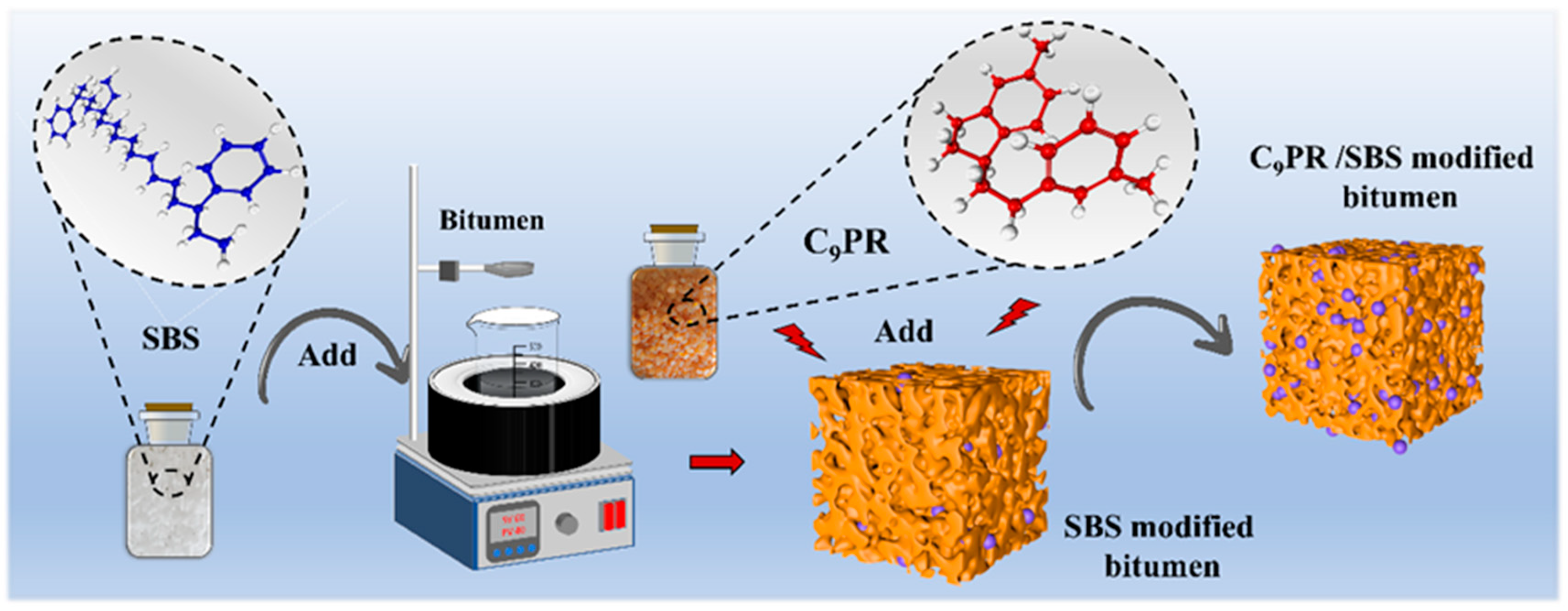
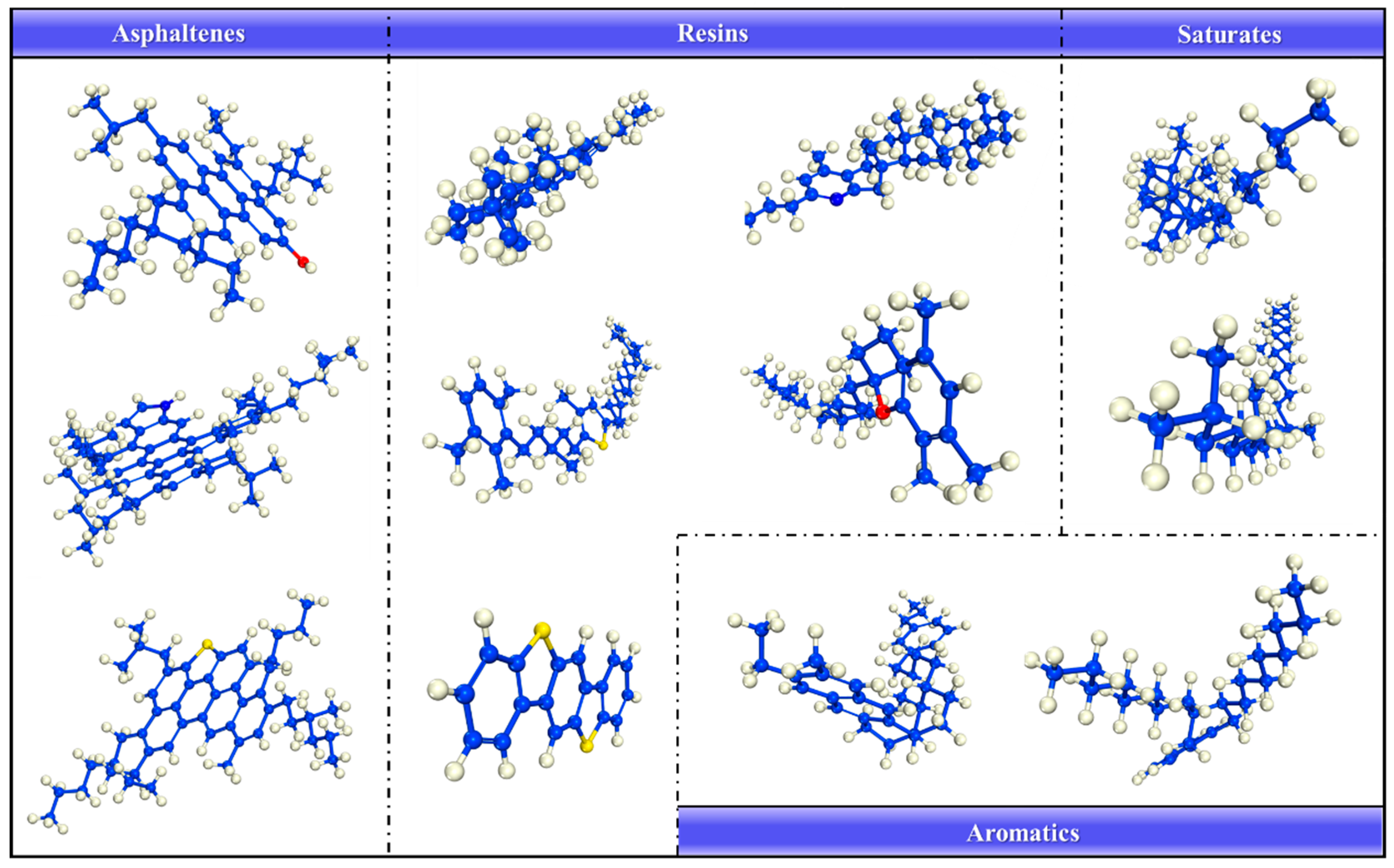
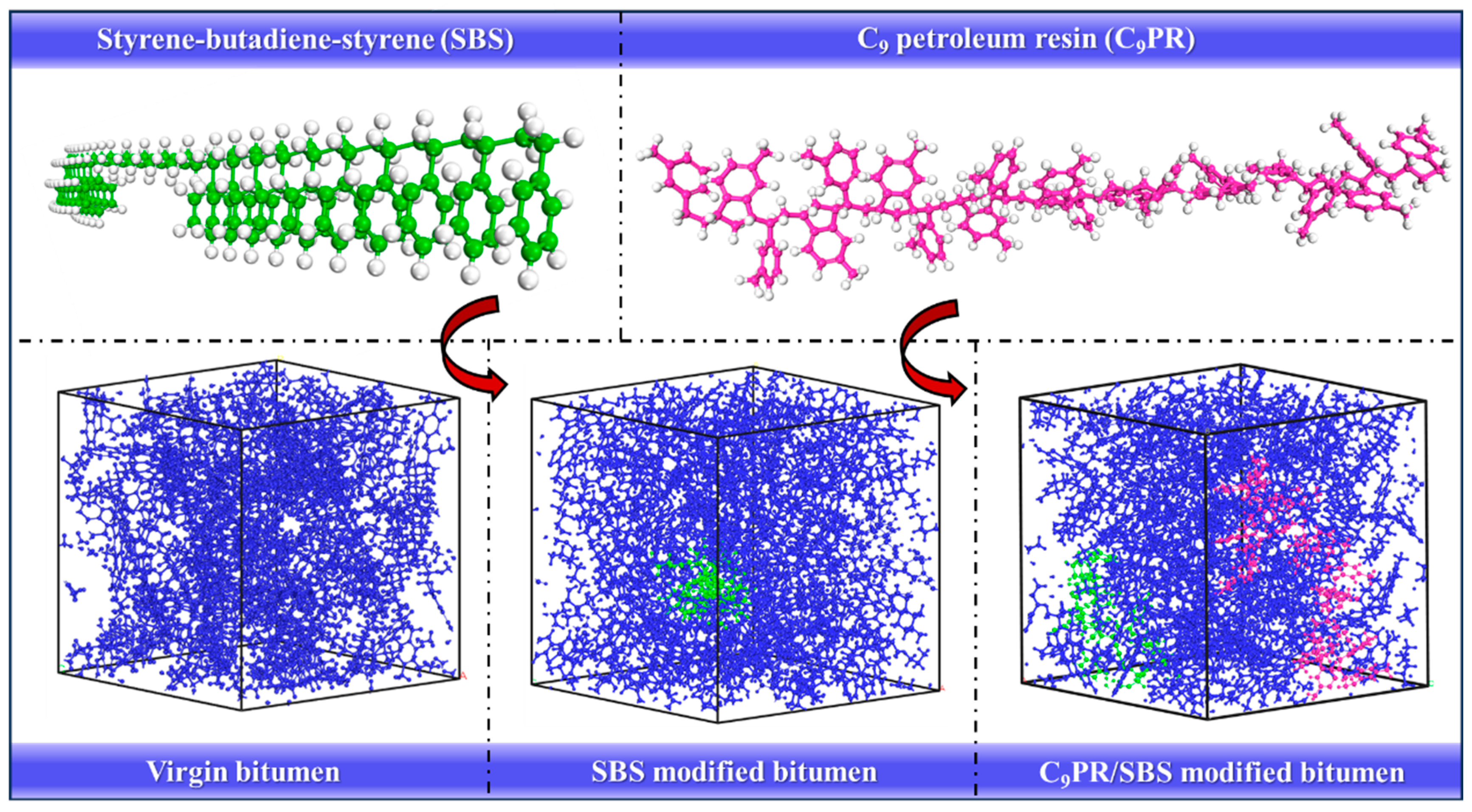


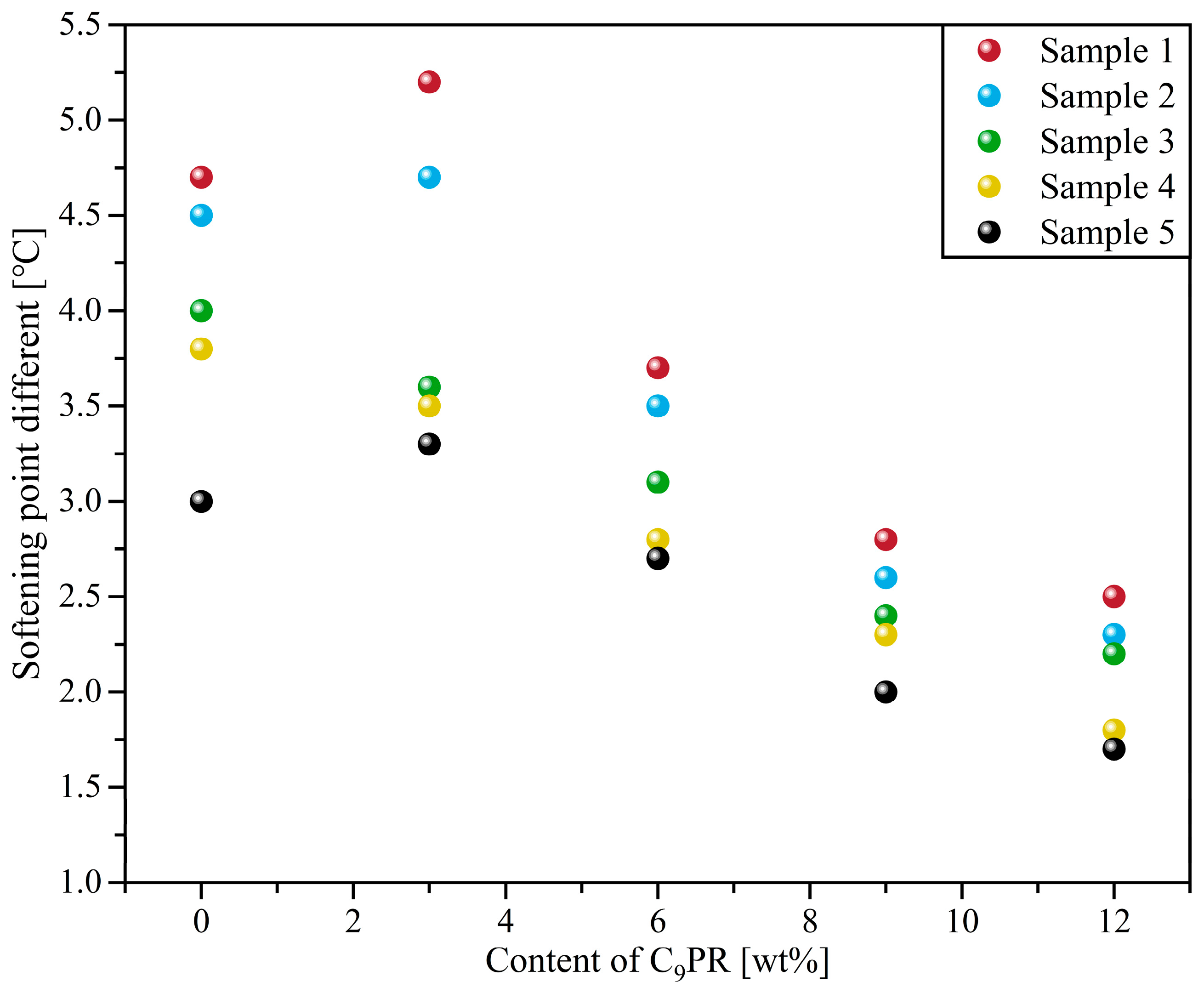
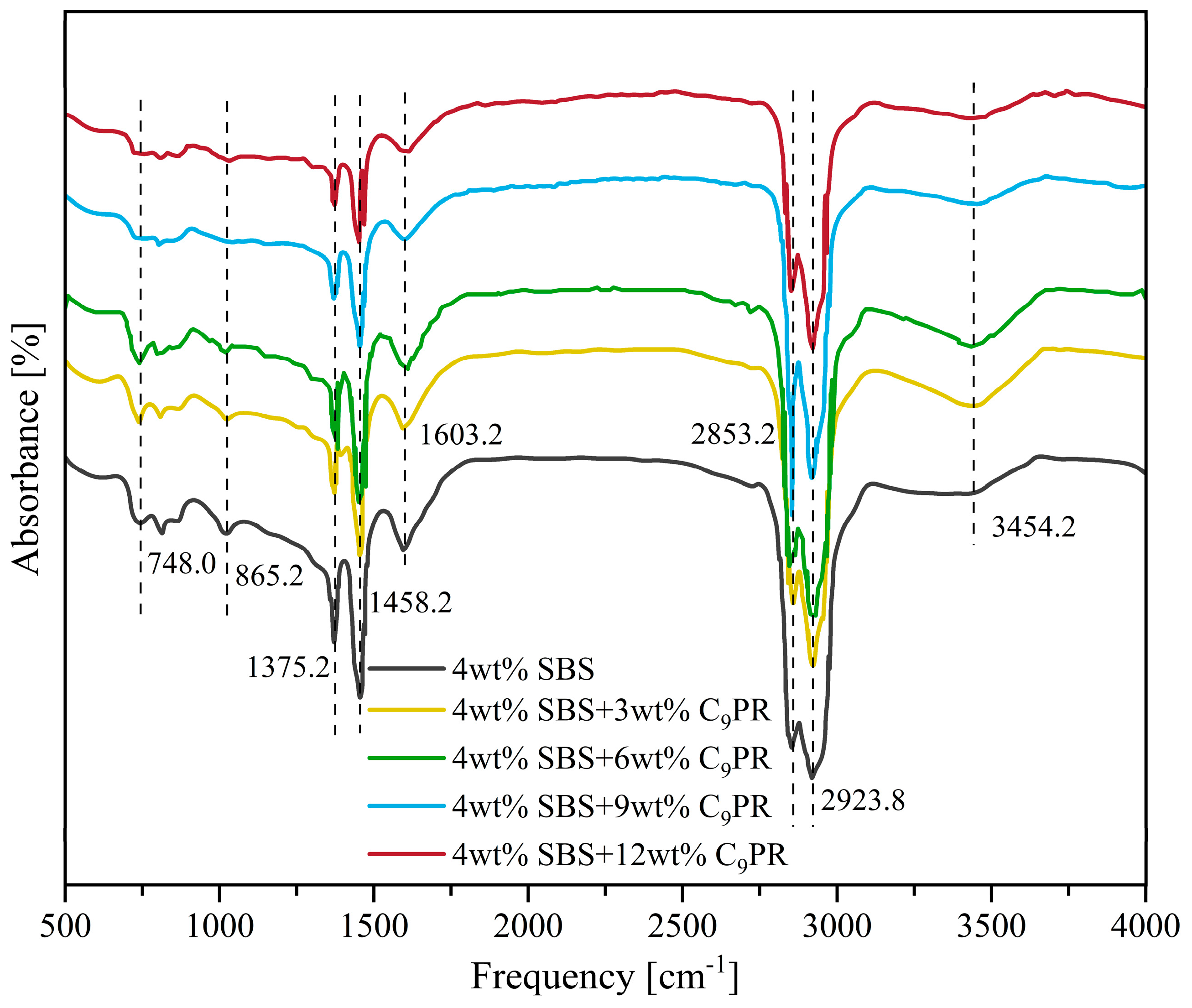
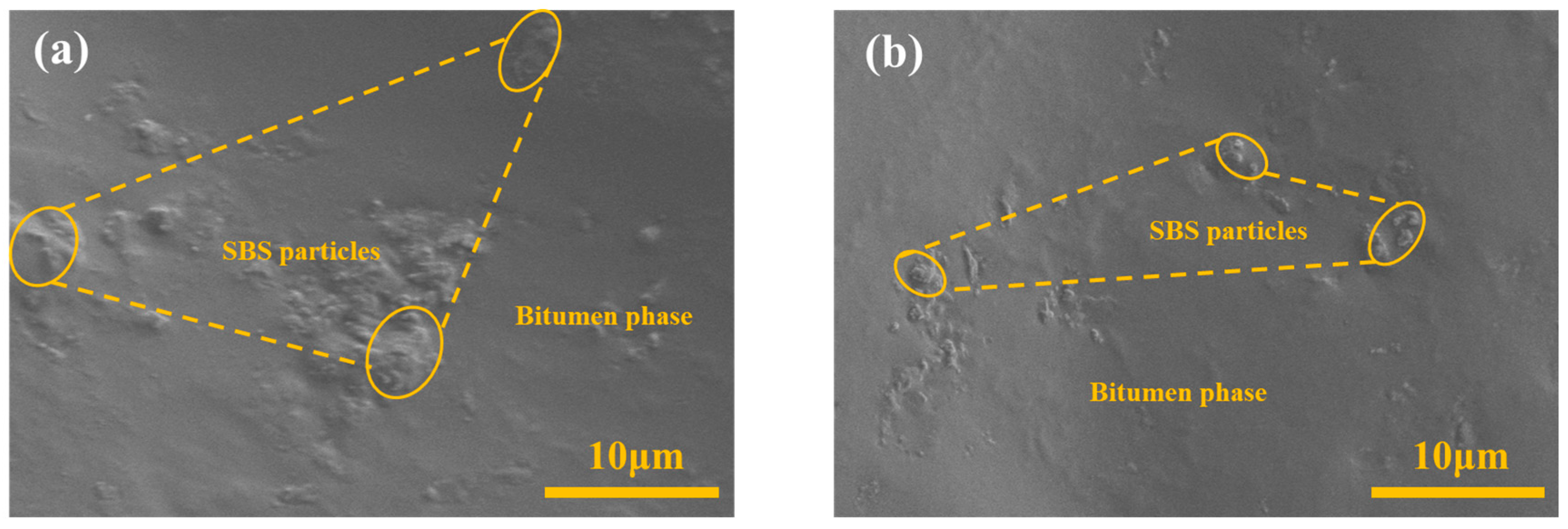

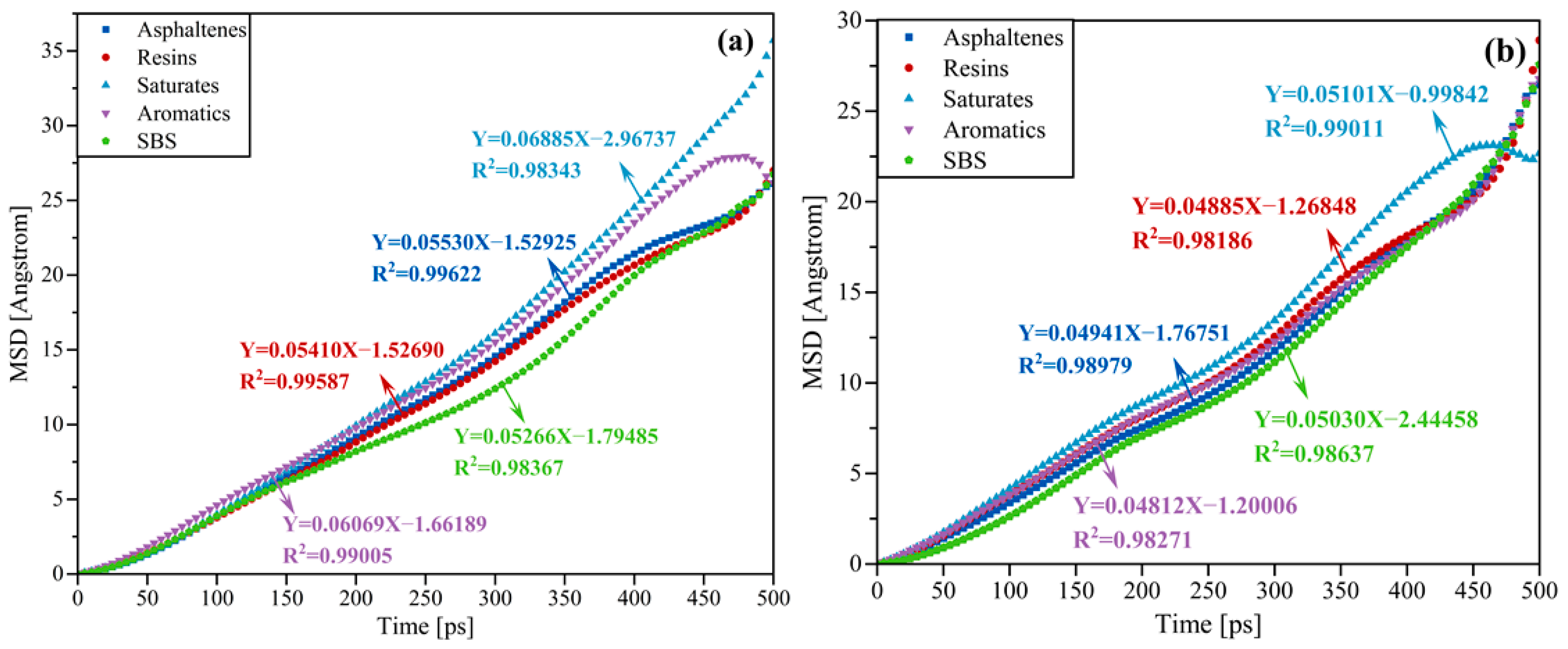
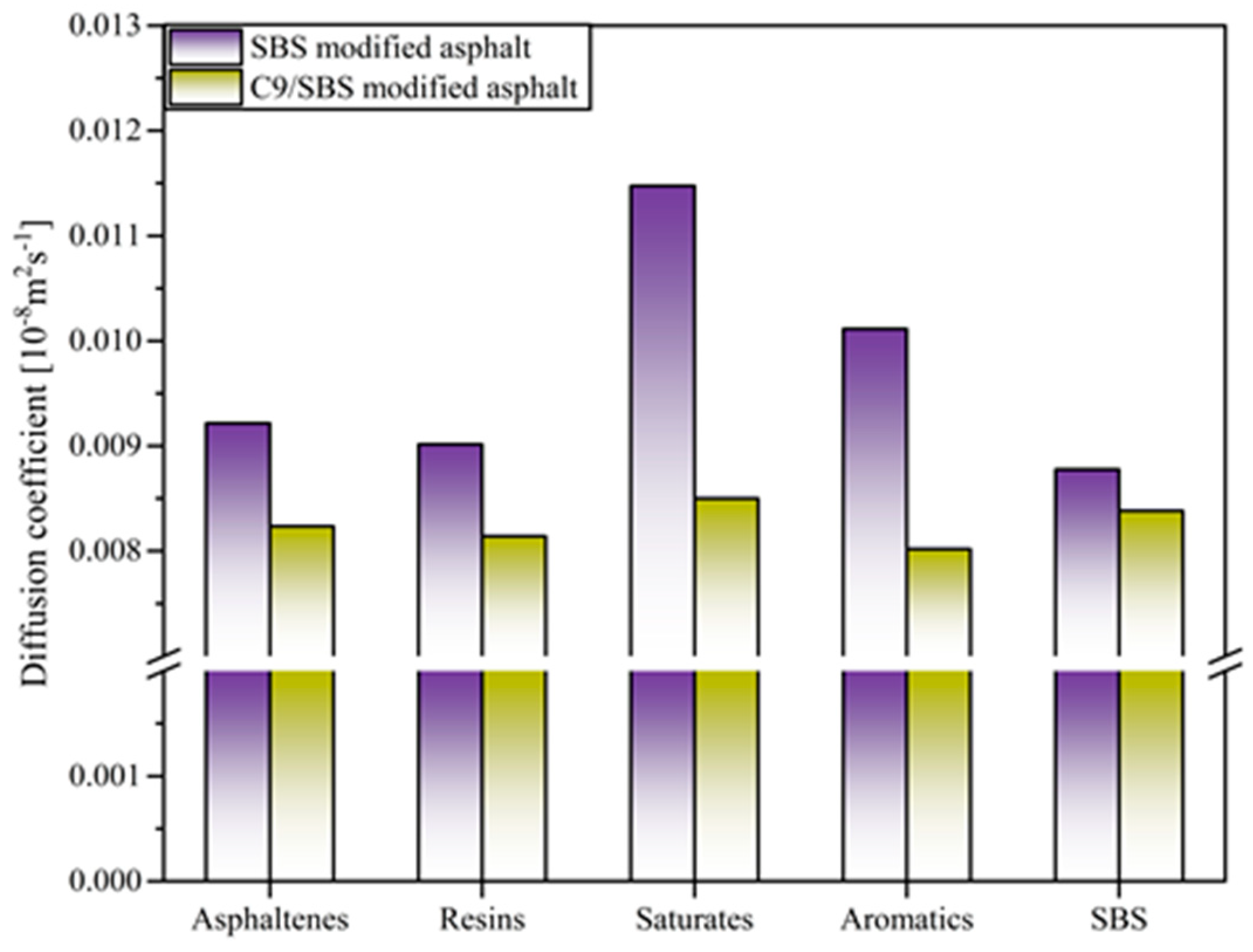
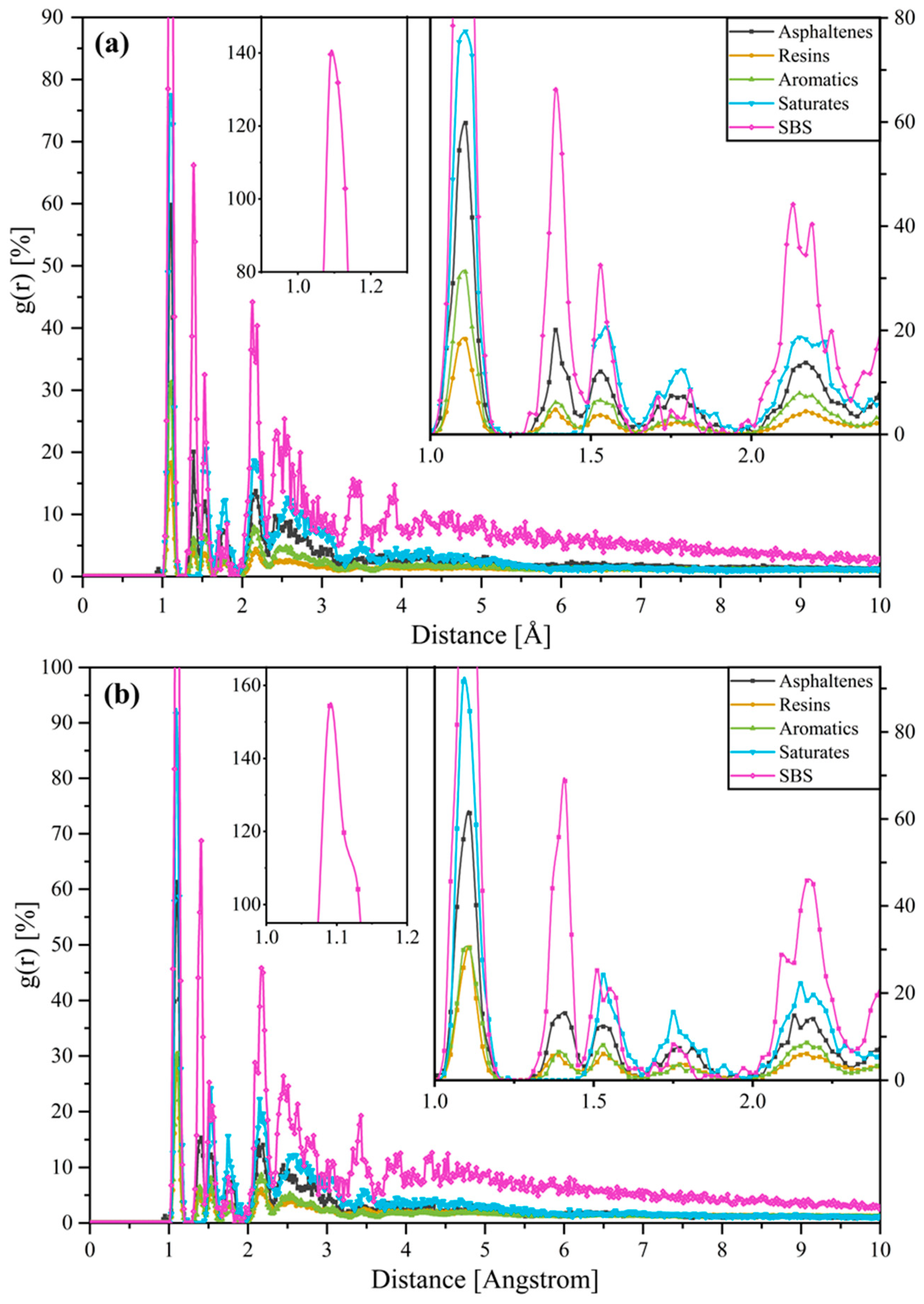
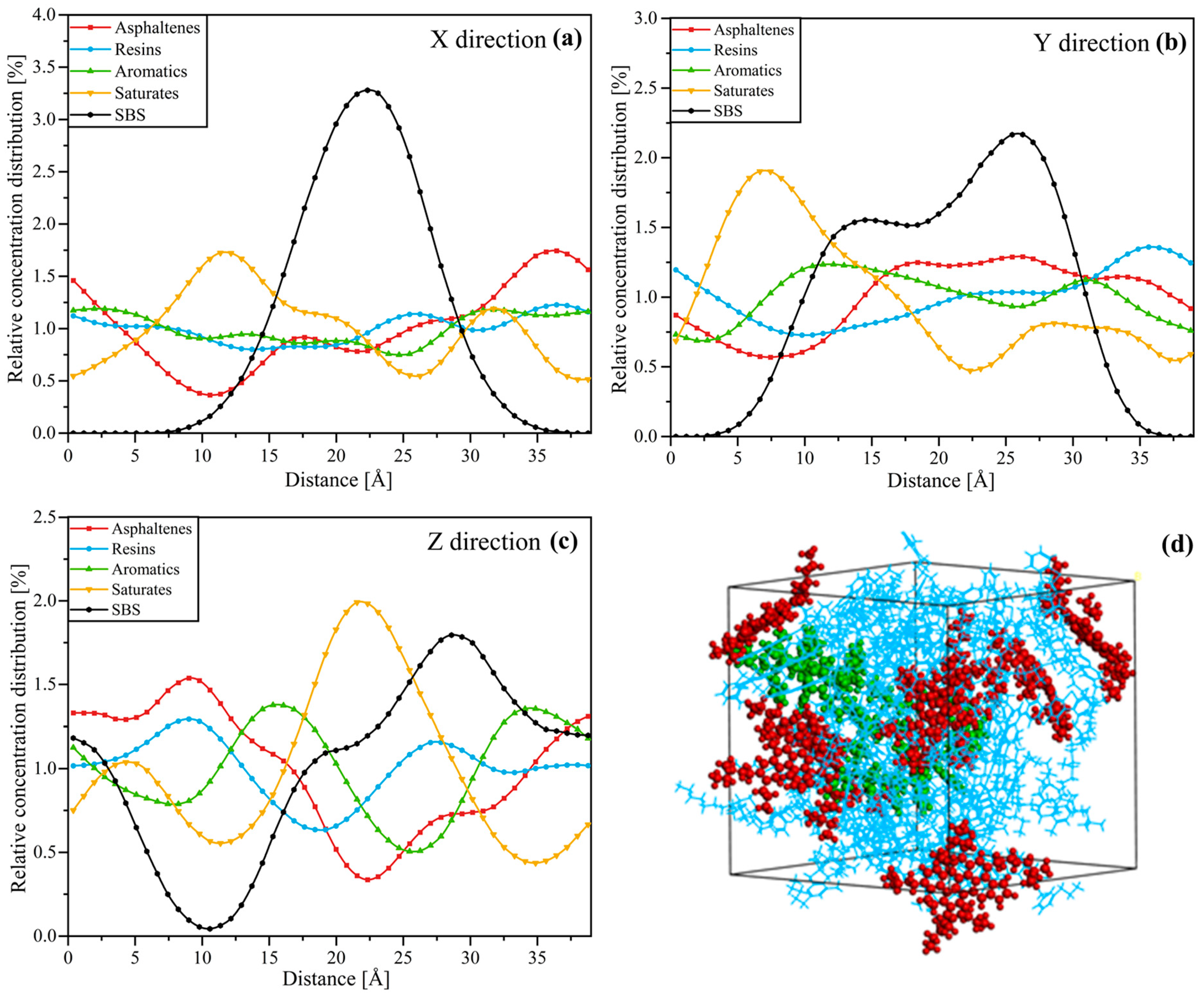
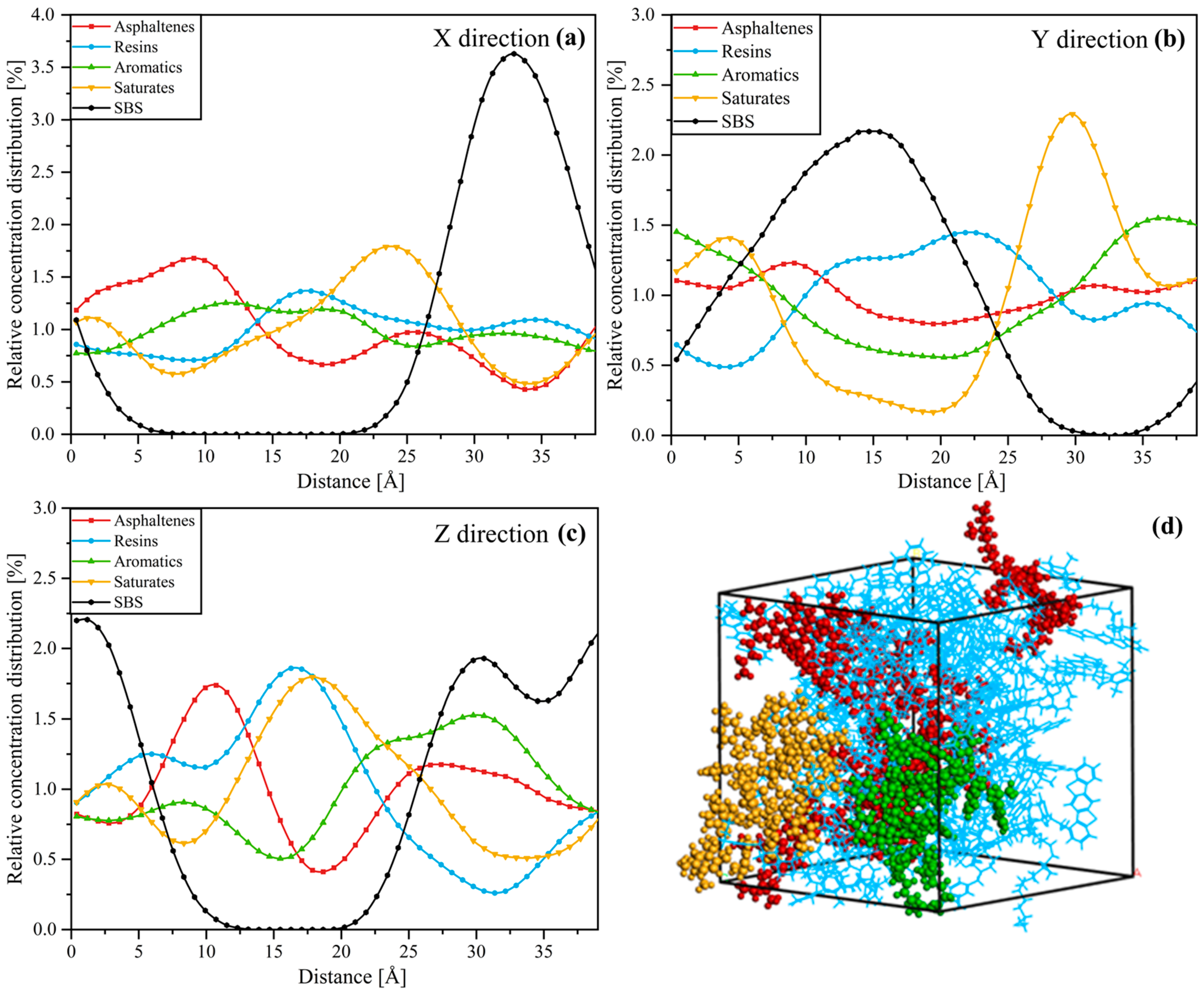
| Item | Unit | Test Results |
|---|---|---|
| Penetration (25 °C, 100 g, 5 s) | 0.1 mm | 65.2 |
| Softening point | °C | 47.5 |
| Ductility (15 °C, 1 cm/min) | cm | 145.0 |
| Viscosity (135 °C) | Pa·s | 0.593 |
| Item | Unit | Test Results |
|---|---|---|
| Softening point | °C | 118.4 |
| Gardner color scale | # | 8 |
| Acid value | mgKOH/g | 0.15 |
| SARA | Molecules | Molecular Formula | Molar Mass (g/mol) | Number | Mass Ratio (%) |
|---|---|---|---|---|---|
| Asphaltenes | Phenol | C42H54O | 575 | 3 | 16.6 |
| Pyrrole | C66H81N | 888.5 | 2 | ||
| Thiophene | C51H62S | 707.2 | 3 | ||
| Resins | Quinolinohopane | C40H59N | 554.0 | 4 | 41.9 |
| Thioisoremieratane | C40H60S | 573.1 | 4 | ||
| Trimethybenzeneoxane | C29H50O | 414.8 | 15 | ||
| Pyridinohopane | C36H57N | 530.9 | 5 | ||
| Benzobisbenzothiophene | C18H10S2 | 290.4 | 4 | ||
| Aromatics | PHPN | C35H44 | 464.8 | 11 | 30.8 |
| DOCHN | C30H46 | 406.8 | 13 | ||
| Saturates | Squalane | C30H62 | 422.9 | 4 | 10.7 |
| Hopane | C35H62 | 483.0 | 4 | ||
| SBS | - | C180H192 | 2355.52 | 1 | 5 |
| C9PR | - | C190H202 | 2485.71 | 1 | 9 |
| C9PR Content | 0 wt% | 3 wt% | 6 wt% | 9 wt% | 12 wt% |
|---|---|---|---|---|---|
| Average values | 4 | 4.06 | 3.16 | 2.42 | 2.1 |
| C9PR Content | 0 wt% | 3 wt% | 6 wt% | 9 wt% | 12 wt% |
|---|---|---|---|---|---|
| Area of SBS | 40,398 | 41,845 | 45,861 | 48,298 | 49,954 |
| Skeleton length of SBS | 295 | 316 | 457 | 674 | 717 |
Disclaimer/Publisher’s Note: The statements, opinions and data contained in all publications are solely those of the individual author(s) and contributor(s) and not of MDPI and/or the editor(s). MDPI and/or the editor(s) disclaim responsibility for any injury to people or property resulting from any ideas, methods, instructions or products referred to in the content. |
© 2024 by the authors. Licensee MDPI, Basel, Switzerland. This article is an open access article distributed under the terms and conditions of the Creative Commons Attribution (CC BY) license (https://creativecommons.org/licenses/by/4.0/).
Share and Cite
Yan, C.; Zhang, T.; Hu, K.; Gillani, S.T.A.; Zhang, W. Evaluation of the Effect of C9 Petroleum Resin on Rheological Behavior, Microstructure, and Chemical Properties of Styrene–Butadiene–Styrene Modified Asphalt. Buildings 2024, 14, 1599. https://doi.org/10.3390/buildings14061599
Yan C, Zhang T, Hu K, Gillani STA, Zhang W. Evaluation of the Effect of C9 Petroleum Resin on Rheological Behavior, Microstructure, and Chemical Properties of Styrene–Butadiene–Styrene Modified Asphalt. Buildings. 2024; 14(6):1599. https://doi.org/10.3390/buildings14061599
Chicago/Turabian StyleYan, Chaoqun, Taoli Zhang, Kui Hu, Syed Tafheem Abbas Gillani, and Wengang Zhang. 2024. "Evaluation of the Effect of C9 Petroleum Resin on Rheological Behavior, Microstructure, and Chemical Properties of Styrene–Butadiene–Styrene Modified Asphalt" Buildings 14, no. 6: 1599. https://doi.org/10.3390/buildings14061599
APA StyleYan, C., Zhang, T., Hu, K., Gillani, S. T. A., & Zhang, W. (2024). Evaluation of the Effect of C9 Petroleum Resin on Rheological Behavior, Microstructure, and Chemical Properties of Styrene–Butadiene–Styrene Modified Asphalt. Buildings, 14(6), 1599. https://doi.org/10.3390/buildings14061599









